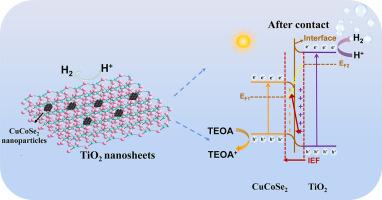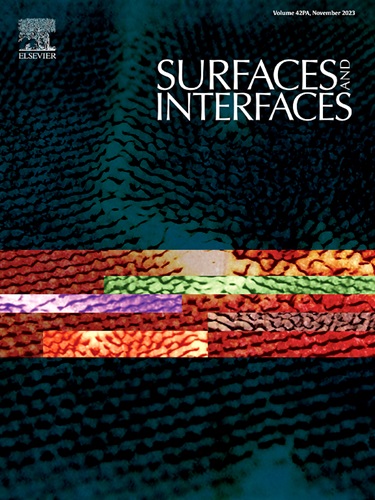Photocatalytic H2 evolution over CuCoSe2 nanoparticles decorated TiO2 nanosheets with S-scheme charge separation route
IF 6.3
2区 材料科学
Q2 CHEMISTRY, PHYSICAL
引用次数: 0
Abstract
The construction of S-scheme heterojunctions via exploring semiconductors with suitable energy band structures can effectively improve the photocatalytic performance of TiO2. In this work, CuCoSe2/TiO2 heterojunction were prepared using solvent evaporation strategy by their different surface charge properties. The investigation indicates that rates of H2 evolution (rH2) of the system increases significantly from 138.1 (TiO2) to 3773.8 μmol·g−1·h−1 (CuCoSe2/TiO2). It is found that the incorporation of CuCoSe2 can extend the visible light absorption range of the system, increase the electrochemically active surface area, facilitate charge generation and decrease the transfer resistance, reduce the H2 production overpotential and the water contact angle. Further investigation reveals that a bimetallic selenide CuCoSe2 exhibit superior enhancement activity compared to their monometallic selenides (CuSe2, CoSe2) due to the synergistic effect of Co and Cu. Especially, the charge transfer between CuCoSe2 and TiO2 follows S-scheme charge separation route, which can effectively enhance charge separation/migration, reserve e− with strong reducing ability in TiO2, thereby promoting the H2 evolution kinetics. Moreover, the heterojunction also demonstrates exceptional stability throughout the cycle experiment. The present work establishes an experimental basis for the advancement of highly efficient and stable bimetallic selenides related heterojunctions in the field of photocatalytic H2 evolution.

采用 S 型电荷分离路线的 CuCoSe2 纳米颗粒装饰 TiO2 纳米片上的光催化 H2 演化
通过探索具有合适能带结构的半导体来构建 S 型异质结,可以有效提高 TiO2 的光催化性能。本研究采用溶剂蒸发策略制备了具有不同表面电荷特性的 CuCoSe2/TiO2 异质结。研究表明,该体系的 H2 演化速率(rH2)从 138.1(TiO2)显著增加到 3773.8 μmol-g-1-h-1(CuCoSe2/TiO2)。研究发现,CuCoSe2 的加入可以扩大体系的可见光吸收范围,增加电化学活性表面积,促进电荷生成并降低传递电阻,降低 H2 生成过电位和水接触角。进一步的研究发现,与单金属硒化物(CuSe2、CoSe2)相比,双金属硒化物 CuCoSe2 由于 Co 和 Cu 的协同作用而表现出更高的增强活性。特别是 CuCoSe2 与 TiO2 之间的电荷转移遵循 S 型电荷分离路线,可有效增强电荷分离/迁移,在 TiO2 中保留具有较强还原能力的 e-,从而促进 H2 的演化动力学。此外,异质结在整个循环实验过程中也表现出卓越的稳定性。本研究为在光催化 H2 演化领域开发高效、稳定的双金属硒化物相关异质结奠定了实验基础。
本文章由计算机程序翻译,如有差异,请以英文原文为准。
求助全文
约1分钟内获得全文
求助全文
来源期刊

Surfaces and Interfaces
Chemistry-General Chemistry
CiteScore
8.50
自引率
6.50%
发文量
753
审稿时长
35 days
期刊介绍:
The aim of the journal is to provide a respectful outlet for ''sound science'' papers in all research areas on surfaces and interfaces. We define sound science papers as papers that describe new and well-executed research, but that do not necessarily provide brand new insights or are merely a description of research results.
Surfaces and Interfaces publishes research papers in all fields of surface science which may not always find the right home on first submission to our Elsevier sister journals (Applied Surface, Surface and Coatings Technology, Thin Solid Films)
 求助内容:
求助内容: 应助结果提醒方式:
应助结果提醒方式:


